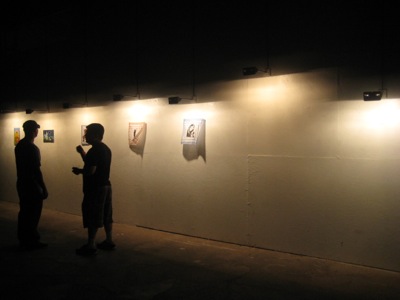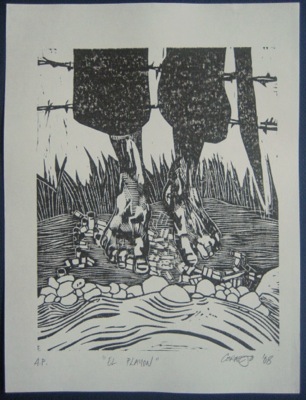Â



(last two pictures taken from BJ’s iphone)
After dinner, we headed down to the warehouse to see Oscar’s artwork and projects from LACAP. I am so happy we were able to snag one of his woodcut prints.Â
There were so many pieces we had our eye on, but this is what we bought—for now :)Â

Oscar told us this woodcut’s title was “El Playón.” He said the word had many meanings, but declined to elaborate, beyond the fact that it named a place in El Salvador. It turns out that El Playón is a volcanic lava bed that, a quarter-century ago, was a notorious dumping ground for the disappeared—the mutilated victims of a brutal regime’s death squads. A later, lesser-known Cold War proxy clash, the El Salvador mess was more or less Reagan’s replay of Vietnam. Both Third World countries were wrecked by civil war, carved in two with one side backed by the capitalists, the other backed by the communists.
Oscar’s work — by intricately crafting scenes where people are, literally and figuratively, overshadowed and haunted by dark symbols: rifles, helicopters, barbed wire — moves you without batting you over the head with political messages. Maybe that’s because the human presence is so prominent in the compositions, and so carefully, creatively rendered. Thus people, not ideas, stay front and center during these trips into history. Far more than clever visual slogans, his work makes us feel the human cost, the suffering of real individuals, families, friends, under these disordered governments, even when Oscar envelops their features in shadow and negative space. Somewhere in between remembering and imagining, each woodcut is an act of sympathy and of memory.
Despite the limits of his medium, the pieces vault above black-and-white simplicity. Pressing sumi ink onto torinoko paper, the tone and texture of the finished work attains a Japanese subtlety of expression that softens the blow of the fiery subject matter. You could say that an idealism, or an optimism, is hiding in these exotic materials. You could imagine that the beauty and promise of nature, through the soot of the ink and the ganpi fibers of the paper, slips through, hinting at a brighter future beyond Oscar’s stark scenes of nature and mankind destroying itself — a future made possible, perhaps, by art itself.